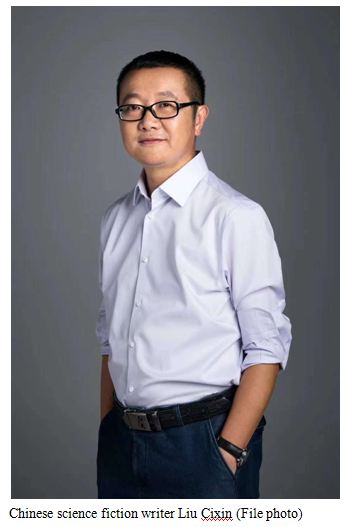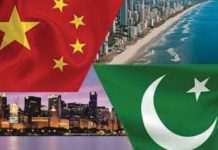By Liu Cixin
I ventured into the realm of science fiction creation, deeply inspired by the wonders of science. I can still vividly recall the exhilaration I felt when reading the news of the first landing by humans on the moon in my childhood. Over the years, I have imagined countless scenarios of Chinese astronauts walking in space. Now, when I see the frequent launches of the Shenzhou spaceships, and watch Chinese astronauts on space missions on TV, I am occasionally overwhelmed by a surreal feeling – are these truly happening?
In recent years, China’s science fiction industry embraced rapid development and received wide attention. This couldn’t have happened without the overall progress of society, including advancements in the aerospace industry and the wide application of Internet technologies. We are amid rapid modernization, industrialization and digitalization, with opportunities and hopes, as well as pressure and challenges. We marvel at the wonders of science, and expect science and technology to bring a better life to human beings. These all provide a fertile ground for the prosperity of the science fiction industry.
Science, the source of strength for science fiction
Science fiction is an outcome of the modern scientific and technological revolution. In the early 19th century, scientific and technological advancement promoted industrial revolutions and triggered people’s imagination and aspirations for the future. That was how science fiction literature came into being.
As mankind entered the age of electricity from the age of steam between the 1920s and 1960s, the progress of science and technology once again demonstrated the overwhelming power to change the world. The revolution in physics, represented by the theory of relativity and quantum mechanics, has brought people whole new horizons. People’s admiration for the power of science and the longing for the future reached a climax during this period, leading to a flourishing era for science fiction works.
Based on science, science fiction creates a sci-fi universe different from the real world. Although science fiction writers imagine the future worlds, they aim not to predict them. It doesn’t really matter whether a science fiction book’s predictions come true in the future when evaluating its quality. Many science fiction writers, including myself, intentionally choose settings that are unlikely to be realized to tell stories, and use novel perspectives to show the wonders and marvels of science, thus allowing people to experience the beauty of science.
After 200 years of development, countless science fiction works have already envisioned the future in various ways, and it is sometimes questioned whether science fiction will continue to be creative in the future. In my opinion, the creativity of science fiction is infinite. Even traditional themes can be revitalized, depending on how you portray them.
For example, the classic science fiction short story “A Walk in the Sun” depicts a sole survivor of a terrible crash landing on the moon, who must keep walking continually on the surface of the moon to stay in the sunlight with a wing-like solar panel, in order to stay alive. This is a straightforward narrative with a classic moon landing theme, yet it is amazingly well-written.
In my perspective, as China’s aerospace technology continues to advance, it would be a big hit to use a “micro-realism” approach to depict how an engineering team builds a space power station and a lunar base.
Moreover, with progress in science, new fields will constantly emerge, offering new themes for science fiction. Highly developed modern scientific fields, such as physics, cosmology, and molecular biology, show us a more magical, broader, and more unpredictable universe and nature, which contain rich resources for science fiction creation. However, they also make basic science today more complicated in theory and more difficult in mathematical expression, which is hard for non-professionals to understand. How to fully tap into these resources is a great challenge for science fiction writers, and also a hope for the development of science fiction literature.
In the face of the unknown, science fiction should always present fresh, original and surprising concepts to keep readers interested. To achieve this, science fiction writers should always maintain a young mindset, keeping their imagination in sync with the times.
To release beauty from scientific equations
Expanding people’s imagination is an important mission of science fiction. The well-known “Gravity,” a very pure science fiction movie, shows us that for science fiction creation, the most important thing for the creators is to have a poetic feeling towards the universe. Good science fiction works present to us a drop of water from a perspective of the vast ocean, bringing people out of their limited vision to experience a broader world beyond reality.
Science is the source of strength for science fiction, while the beauty of science is often confined within scientific equations. Ordinary people need to make tremendous efforts to catch a glimpse of its brilliance. But once it is presented, its impact and power of purification to our soul are immense, which is difficult to be achieved by other genres of literature. Science fiction is a bridge to the beauty of science, releasing this beauty from equations and presenting it to the public.
The success of science fiction largely depends on the attraction of their mind-blowing imagination. The Big Bang theory of modern cosmology is spectacular and awe-inspiring. The long journey of life evolution is twisted and romantic. The poetic view of spacetime in general relativity, the magical microcosm in quantum physics… The worldview revealed by science is far beyond our imagination. How can writers present such beauty of science?
“Macro-detail” is a technique exclusive to science fiction literature. Although every narrative needs details, the treatment of details has evolved in science fiction. I can imagine a short story—I will call it “Singularity Fireworks”—which describes a group of super-consciousnesses for whom the Big Bang is nothing more than a firework display. The work uses a few words to depict the talks and feelings between two entities before and after the firework, yet it encompasses the history of the universe since the Big Bang in spacetime, unfolding a vision of a supra-cosmos beyond our universe. In my opinion, this kind of “macro-detail” best embodies the characteristics and advantages of science fiction literature.
Since engaging in science fiction creation, I have been looking for story resources from scientific and technological advancements, endeavoring to express the direct and tangible connection between the insignificant human and the grand universe based on scientific principles. In the beginning, the universe was smaller than an atom, and everything was one. This determines the natural connection between the minuscule parts of the universe and the grand whole. Even though the universe has expanded to today’s scale, I believe this connection still exists, and the evolution and changes of the universe are closely related to the lives and destinies of every human being. When I create stories, I always endeavor to envisage several scenarios of the specific connection between humans and the universe, and turn this imagination into captivating and uplifting tales.
Of course, science fiction does not always depict the future and imagination; it also encompasses the present and reality. Taking my novel “The Three-Body Problem” as an example. The first part portrays a fictional past with a strong sense of reality, in order to spark readers’ imaginations. The second part is a long journey from reality to imagination. The third part is a pure science fiction novel with a prominent “science fiction fan” vibe. Starting from reality to a distant and ethereal world is a typical structure of traditional science fiction, and also a narrative mode that Chinese science fiction readers are accustomed to, from reality to the future.
To seize the chance for innovative development
Science fiction movies have had a significant impact on me. The way I tell stories and construct visual imagery are both influenced by science fiction movies. Images are powerful, and many imaginative concepts in science fiction can only be portrayed through visual means. In this regard, films have a significant edge over printed words.
However, due to the low publishing cost and the relatively fixed readership, authors have more room for creation and can explore more innovative ideas and storytelling techniques. The production cost of science fiction films is much higher, as they need to fight for a wider and more diverse audience’s attention. Films need to consider audience acceptability of innovative forms and content, and find a balance point in artistic expression.
In recent years, both science fiction literature and films have played to their respective strengths. The adaptation of some science fiction novels into films and TV series has brought science fiction to a wider audience, driving the growth of the science fiction industry. To further develop science fiction literature today, efforts should be made to expand the pool of Chinese science fiction writers, so that more talents and works will emerge. The development of science fiction films and TV series requires an increase in talent and experience reserves, providing more opportunities for the new generation of screenwriters, directors, and producers to participate in creation. Additionally, it is crucial to strengthen international cooperation and accumulate more mature production experience.
Promoting the development of science fiction raises new requirements for literary theory and reviews. For example, the technique of “macro-detail” and other science fiction creation methods urgently need theoretical refinement to form a conscious expressive technique. Science fiction criticism also needs to keep pace with the times, breaking free from the constraints of using an outdated perspective to view new works and phenomena. Innovative theories and sharp, vibrant comments can certainly drive the development of science fiction creation.
Science fiction works contribute to cultivating the science fiction imagination of young people, stimulating their creativity and innovation abilities. Science fiction education can be properly introduced into school education, by adding science fiction content to textbooks, or cultivating children’s interest through online science fiction creations. It is believed that a considerable number of young readers and viewers will enjoy science fiction, thereby initiating a conscious exploration of science fiction and science.
Chinese science fiction has shown great momentum and potential. We must seize this opportunity to make the industry stronger.
(The article is compiled by Dong Yang based on an interview with Liu Cixin.)
Liu Cixin was born in Yangquan, north China’s Shanxi province in 1963. He has a bachelor’s degree and is a senior engineer, as well as a science fiction writer and a member of the China Writers Association. His representative works include the novels “Supernova Era,” “Ball Lightning,” and “The Three-Body Problem” trilogy, as well as short fiction such as “The Wandering Earth,” “The Village Teacher,” and “Full Spectrum Barrage Jamming.” “The Three-Body Problem” trilogy is widely regarded as a milestone in Chinese science fiction literature.













